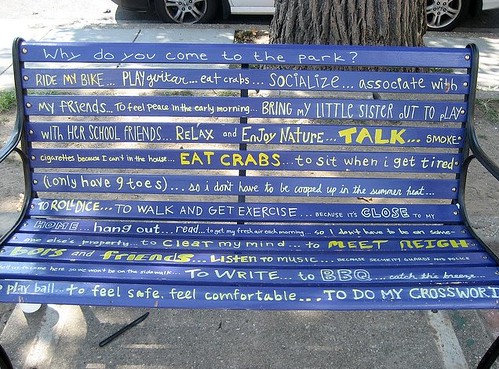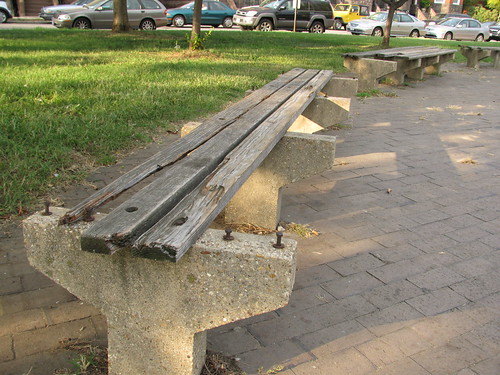Post modern parks: concrete and empty of people


I forgot to mention in the recent blog entry on parks that I came across the city's re-do of a "pocket park" at 14th Street NW between Ogden and Oak Streets in the Columbia Heights neighborhood.
This park was the subject of a 2009 story in the Washington City Paper, "Bench Warfare: In Columbia Heights, a couple of benches can cause a neighborhood uproar," about a "temporary urbanism" project where an artist had installed benches featuring text from a community survey. (I wrote about this issue in 2009 as well.)
From the article:
... Originally from Massachusetts, Tooley came to D.C. to attend American University, then stuck around for five more years after graduation, living in Columbia Heights. Petite with dark brown hair, she moved to Baltimore last year to complete a masters program in community arts at the Maryland Institute College of Art.
Tooley applied for a $1,000 grant with the D.C. Commission on the Arts and Humanities, got the money for the bench-restoration project—she pitched it as a temporary installation, knowing full well that the park was slated for a renovation—and threw a barbecue in the triangle during the spring of 2008. Some 60 people munched on hot dogs and hamburgers and helped her fill out a survey she had put together asking the following questions:
• What is your happiest memory in the park?
• Why do you come to the park?
• What is your saddest memory in the park?
• Why is this park important to you?
• What makes a community safe?
• Why do you think the benches were taken out?
• What would you change about this park?
Two years after she first conceived the project, Tooley finally saw her benches installed in the park last month. She’d finished painting them by early summer 2008. But the project stalled while she waited for another $500 grant to come through, so she could hire a welder to help put them in.

Park bench by Sarah Tooley. Image from the Prince of Petworth blog.
Tooley had colored them bright red, green, yellow, blue, purple, black and orange, and they had vibrant, sharply contrasting lettering in a variety of styles across the wooden beams. The words painted on the black bench, which answers the question Why do you think the benches were taken out?, take on an angry tone: “Because the police and government are unprofessional.…People hating on us.…They don’t want us to have our freedoms…”
Others are lighter: Why do you come to the park? “To play guitar…eat crabs…to roll dice…to walk and get exercise.”
People who live in cities aren't strangers to the fact that urban parks, especially pocket parks, have their good and bad qualities.
A bench for someone to sit on isn't just good for a tired child or senior, it's a great place to sit all day and drink cheap beer, especially if you have a lot of time on your hands, such as being unemployed or retired.
So in neighborhoods where you have mixed income dynamics, with low income and higher income folks in pretty close quarters, not separated, benches in parks can be touchpoints for firestorms, and that's what happened in Columbia Heights over the Sarah Tooley project.
There is no good solution. I argue that if you design the park right, so that it is more open to the street, that there is more observation and surveillance from the street, so that negative behavior tends to be crowded out.
But I understand this is a more theoretical position. E.g., the pocket park in my extended neighborhood of Takoma, at 4th Street and Blair Road is basically controlled by people who stay throughout the day in the park, drinking cheap beer (I know, because on my way from the subway station, I pick up recyclables, and the park and its trash cans is usually teeming with empty beer cans and bottles, as well as some liquor bottles--usually cheap vodka).
Although I argue that this is because the park has a set of benches in the middle of the park, facing inward, and "hidden" from passing traffic by trees. Not to mention that Blair Road traffic isn't as engaged in the surroundings compared to pedestrians, and comparatively speaking, there aren't as many pedestrians in Takoma as in other neighborhoods.
But creating the post-modern park in its place: All concrete; Barren; No place to sit; No possibility of greenspace; is not the solution either.
Don't get me wrong, I am ok with majority hardscape park spaces in commercial areas, depending on their nature, such as the square (really a semi-circle) and fountain at 14th Street and Park Road just up the street from this paved over monstrosity. Places that function as community squares justify hardscaping.
But hardscaping and posts--they may as well be spikes--as a defense against people using the park, what kind of parks and open space planning program is that?
Contrast that with the Eagle Scout project of Peter Riehle, who fixed up the rotted benches of one of the sections of the park at 8th Street and Pennsylvania Avenue SE at Eastern Market Metro. I wrote his project up in the blog entry, "New Years post #3: How about more community self-help (Peter Riehle and Eastern Market Metro Plaza)."
Before. Photo by Gary Barbour.

After. Photo by Peter Riehle

Labels: civic assets, parks and open space, participatory democracy and empowered participation, provision of public services, public art, public space management



0 Comments:
Post a Comment
<< Home